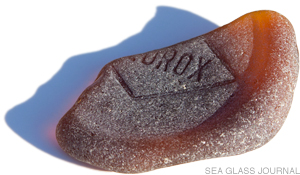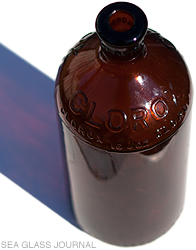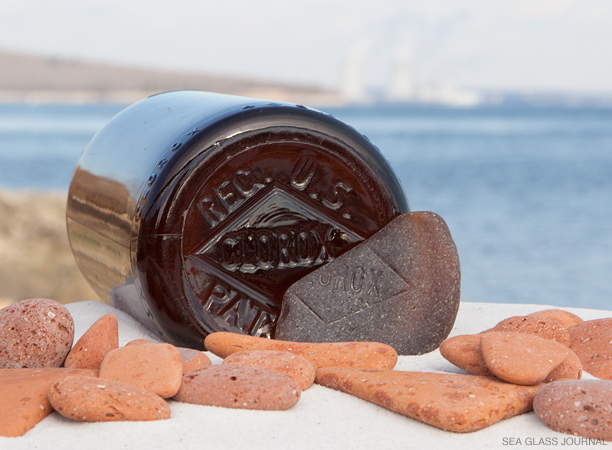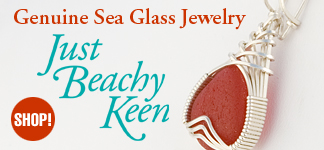The Sea Glass Shard of the Month: December 2015
Clorox Amber Sea Glass Base Segment

Sea Glass Specifications:
Color: Brown
Max Length: 62.2 mm (2.45")
Max Width: 35.8 mm (1.41")
Max Thickness: 5.8 mm (0.23")
Weight: 23.6 grams (0.83 oz)
Estimated Age: Early 1930s
In the spotlight for this month is a bottom section of the ubiquitous Clorox amber brown glass bottle found on many coastlines around the United States. This shard was easy to identify by the familiar diamond-shaped Clorox trademark. This specimen was specifically selected for the final month in 2015 as the Clorox company has been celebrating its 100th anniversary this year, started by five businessmen in 1913 to manufacture liquid bleach.

Shown here is the type Clorox pint-sized bottle from the early 1930s that our featured sea glass shard would have come from.
Facts of Interest
The Clorox Chemical Corporation began in 1913 as The Electro-Alkaline Company.
1914 The Clorox brand name was registered and the diamond trademark was adopted.
From 1918 to 1933 the "pint-sized" Clorox bottle was actually only 15 ounces.
"The switch to using plastic began in 1960..."
The company initially began commercial production of industrial-strength bleach distributed in five-gallon crockery jugs. Beginning in 1918 and through 1928 Clorox began selling to American households in pint-sized amber glass bottles. Because these bottles were also made for distribution by other companies there were no identifying markings to indicate it was a Clorox bottle. This can be useful dating information if you happen across this type of bottle top or bottom.
By 1929 Clorox began distributing their bleach in bottles specifically made for them with the Clorox brand name embossed on the side and the trademark debossed on the bottle base. The approximate dating of these bottles can be determined by various changes and additions to the design, size and information embossed on them.
Between 1929 and 1940 the tops of the various sized Clorox bottles had rubber stopper closures. Beginning in 1940 the company began using bottles with screw tops. The switch to using plastic began in 1960 with 1962 being the last year Clorox was sold using amber glass.
As for dating the Clorox shard featured here, notice that the trademark is the only imprint found on the bottom. Since later bottles included information such as the bottle maker's mark and the Reg US Pat Off marks (see photo below) we can conclude this shard belonged to a pint bottle from the early 1930s.
Due to the magnitude of Clorox bleach sales in the US, finding amber colored sea glass from this source will be fairly common. It does become more unique when you can locate a shard that has all or part or the Clorox trademark as this definitely identifies your find. And because Clorox stopped distributing the bleach in glass in 1962 you are assured that your sea glass specimen is at least over 50 years old!
REFERENCES:
1. http://www.thecloroxcompany.com/company/heritage/

Keep up-to-date on all things sea glass... "Like Us" on Facebook!
Sea Glass Journal on Facebook






